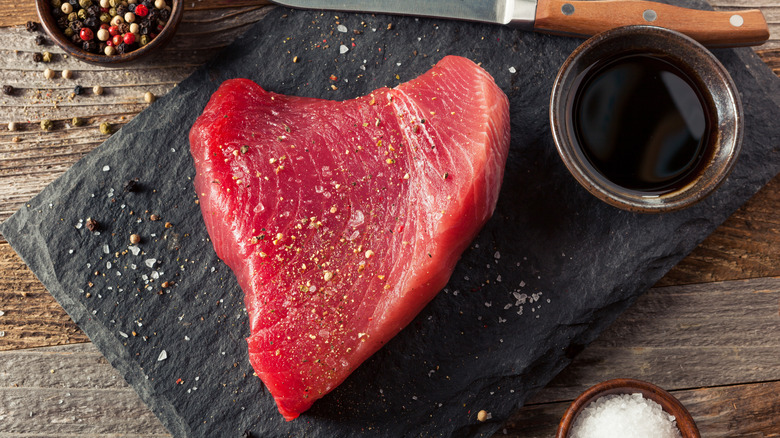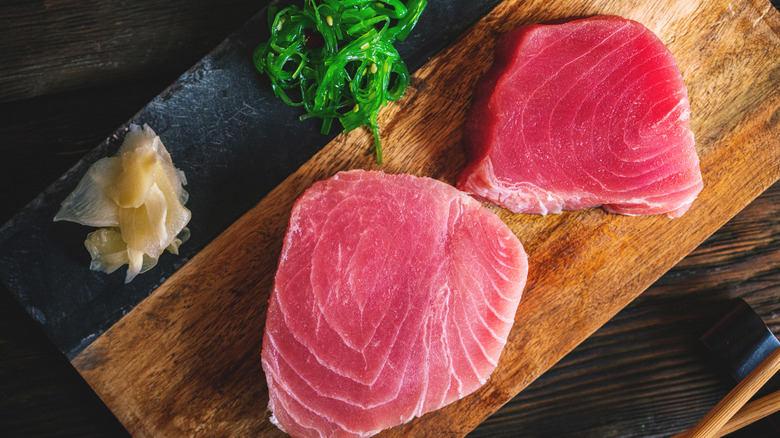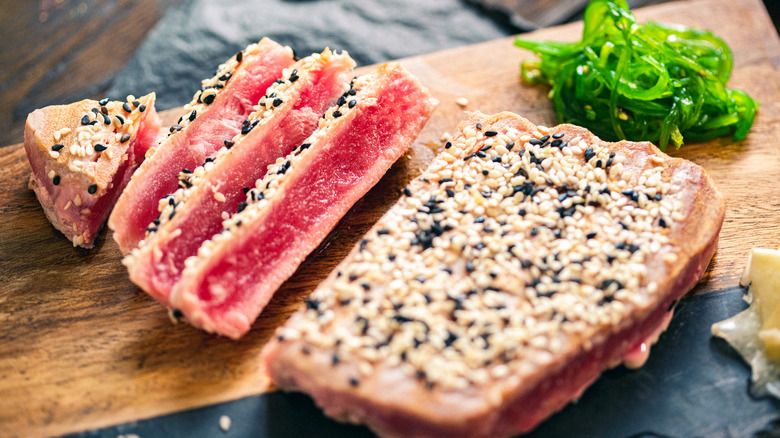The Common Mistake That's Ruining Your Tuna Steaks
Tuna steaks are one of the singular joys of seafood lovers, marrying the meaty consistency of a steak with the delicate yet bold flavors of a quality piece of tuna. But there are plenty of ways to get them wrong. Overcooking them is the most obvious one, as it really doesn't take long to perfectly sear a tuna steak (and there's a question of whether ahi tuna should be cooked at all). But another key mistake people often make with tuna steaks is in another direction: Seasoning them too much.
There's not one way to overdo the seasoning on a tuna steak; there are several. You might use too many different spices, creating a flavor miasma that refuses to stick to one theme. You might use dried herbs, which don't belong on a seared tuna steak. Or you might season them too heavily; like their beef-based namesakes, tuna steaks don't need all that much in the way of seasoning.
Tuna steaks really need a delicate touch
Let's start with the last one because it's probably the single biggest mistake many people make when it comes to overseasoning tuna. Sure, you can season tuna steak heavily and have it work (blacked ahi steak sandwiches are a delicious thing), but this is a piece of fish that honestly doesn't need it. Much like Montreal steak seasoning is tasty, but a steak doesn't need it to taste good; tuna steak can get by with little to no seasoning. It has such a delicious flavor all on its own that all you need is salt and pepper to bring that out. That's the reason most recipes you see don't call for a lot of different or heavy seasonings for the fish itself.
When I make them (which is at least twice a month), I generally only use salt and pepper, and maybe some sesame seeds — and I'm a person who tends to heavily season other proteins like pork or salmon. If you really need extra flavor beyond that provided by a tuna steak, you can always make some sort of dipping sauce (an Asian-inspired combination of ingredients like soy sauce, ginger, green onions, rice vinegar, and toasted sesame oil is a favorite). You can also go with a marinade, which many chefs swear by.
Don't use too many seasonings, or any dried herbs
That's not the only seasoning mistake people often make with tuna steaks. Another is a more general cooking problem: Seasoning blends with too many disparate flavors. Seasoning blends with a lot of ingredients can certainly work, but you have to know what you're doing. It's a bad idea to combine something like turmeric, mustard powder, cinnamon, and mint. If you really want more seasoning on your tuna steak than just salt and pepper, at least stick with a theme.
Another issue is dried herbs, especially if you're working with a cast iron pan (which is a great vessel for tuna steaks). Dried herbs have plenty of uses, but if you sear your tuna steak in a cast iron, leave off the dried herbs. The issue here is that the right way to cook a tuna steak is a fast sear on high heat to rare or (at most) medium-rare. Cast irons are designed to maintain high heat, and while that's what you want for a perfect sear, it's just going to burn the dried herbs. You can add herbs later — something like fresh cilantro works well with tuna steak — but you should do this at the finishing stage or as part of the sauce.
When it comes to seasoning tuna steak, less is more. If you want extra flavors, bring them in a marinade or dipping sauce.


